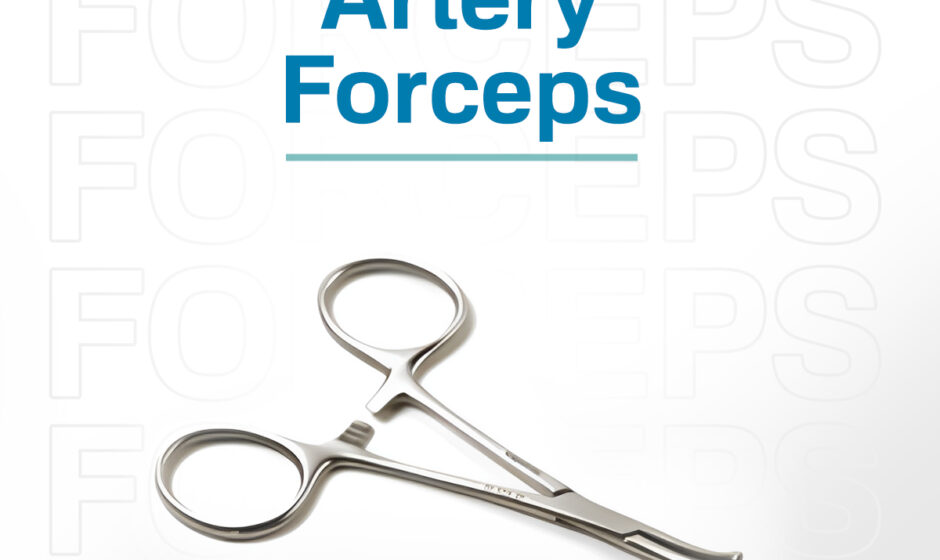In the world of surgery, tools play a key role in the success and safety of each procedure. Among these essential tools, artery forceps stand out as one of the most commonly used instruments. These forceps are used in almost every type of surgery, from minor procedures to major operations. Understanding what artery forceps are, how they work, and their many uses can give us a better idea of how important they are in the medical field.
What Are Artery Forceps?
Artery forceps are surgical instruments designed to clamp blood vessels. Their main purpose is to stop bleeding by holding the blood vessels shut. They are often made from stainless steel and come in various sizes to suit different surgical needs. The design of artery forceps includes a locking mechanism that helps hold the vessel firmly in place without constant pressure from the surgeon. The tips are usually curved or straight and may be serrated to grip tissues better.
These forceps were originally created to help control bleeding during surgery, but over time, their function has expanded. Surgeons and medical staff rely on them to manage tissues and small structures, as well as for other support during an operation. Their ease of use and practical design make them a regular part of surgical kits in hospitals and clinics worldwide.
Artery Forceps Uses in Surgery
The uses of artery forceps are wide and varied. One of the most important artery forceps uses is to clamp arteries and veins during surgery. This helps reduce blood loss and gives the surgeon a clear view of the area they are working on. By doing this, the forceps make surgery safer for the patient and easier for the medical team.
Another common use of artery forceps is in the handling of tissues. When surgeons need to move or hold tissues aside, they often use these forceps. Their firm grip and locking system allow the surgeon to keep tissues in place without using their hands, which is especially helpful during long or complex procedures.
In addition to controlling bleeding and handling tissues, artery forceps can also be used to grasp and remove foreign objects. In emergency rooms, for example, doctors might use them to remove items stuck in wounds or body cavities. The fine tips and strong grip make artery forceps ideal for this kind of delicate work.
Types of Artery Forceps
Though the basic design remains the same, artery forceps come in several forms to suit different tasks. The two main types are straight and curved artery forceps. Straight forceps are often used in surface procedures, where the area is easy to reach. Curved forceps, on the other hand, are better for deeper or harder-to-reach areas. The curved tip allows for better access and visibility during surgery.
Some well-known types of artery forceps include the mosquito forceps and the Kelly forceps. Mosquito forceps are smaller and used for fine, delicate work, while Kelly forceps are larger and more suitable for clamping bigger vessels. Each type serves a specific purpose, but all share the same goal: to help the surgeon manage bleeding and tissues during a procedure.
The Use of Artery Forceps in Different Medical Fields
The use of artery forceps is not limited to one type of surgery. In fact, they are used in nearly every branch of medicine that involves surgical procedures. In general surgery, they help in clamping vessels and holding tissues. In dental surgery, smaller forceps are used to manage bleeding in the gums or inner mouth.
In orthopedic surgery, artery forceps assist in holding tissues and stopping bleeding around bones and joints. Even in veterinary medicine, the use of artery forceps is common. Animal surgeries require the same level of care and precision, and these forceps help ensure safe outcomes for pets and livestock alike.
Obstetrics and gynecology is another field where artery forceps are highly useful. During childbirth, for example, they may be used to clamp the umbilical cord or manage bleeding. Their ability to work in both minor and major procedures highlights how important they are across medical fields.
Importance of Quality and Maintenance
Since artery forceps are used so often and for such delicate tasks, quality is very important. A well-made pair of forceps can last for many years and provide reliable performance in every procedure. Stainless steel is the material of choice because it resists rust and is easy to clean and sterilize.
Proper maintenance also plays a big role in how effective artery forceps are. After each use, they must be cleaned thoroughly to remove blood and tissue. They are then sterilized to prevent infection. Surgeons and staff regularly check them for signs of wear or damage. A faulty instrument can lead to serious problems during surgery, so regular inspection is key.
Training and Handling
Even though artery forceps are simple in design, proper training is needed to use them well. Surgeons, nurses, and surgical assistants must all learn how to use them without causing damage to tissues or vessels. Poor use can lead to unnecessary injury or blood loss. Medical training includes practice on models or cadavers to ensure skillful handling of artery forceps before they are used in real-life operations.
Knowing how much pressure to apply and how to position the forceps correctly are part of this training. With enough practice, medical professionals can use artery forceps with ease and accuracy, which greatly improves patient care.
Final Thoughts on Artery Forceps
Artery forceps may seem like simple tools, but their value in surgery cannot be overstated. They are among the most trusted instruments in any operating room. From clamping vessels to holding tissues and removing foreign objects, their functions are wide and important. The many artery forceps uses across different fields of medicine show just how vital they are.
Surgeons depend on their quality, durability, and design to perform safe and effective procedures. With proper care, training, and handling, the use of artery forceps will continue to support better outcomes in medical care. Whether in a small clinic or a large hospital, these instruments help save lives every day.
Understanding the use of artery forceps not only highlights the skill of surgeons but also shows the importance of the tools they use. As medical technology grows, instruments may change, but the need for reliable tools like artery forceps will remain strong.
More info: Artema Medical



